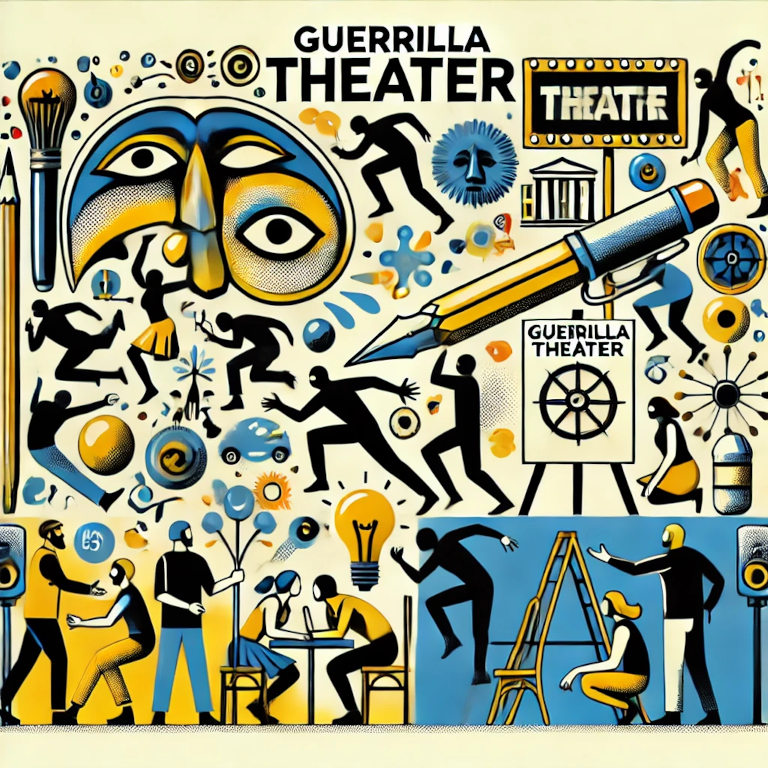Guerrilla theater is a dynamic and unconventional form of performance art that brings theater to public spaces, engaging unsuspecting audiences in spontaneous and thought-provoking ways. As an expert in Entertainment, I will explore the essence of guerrilla theater, its history, techniques, and the impact it has on both performers and audiences. This article will provide valuable insights into guerrilla theater, offering a deeper understanding of its significance and how it enriches the world of entertainment.
Understanding Guerrilla Theater
Guerrilla theater, also known as street theater or radical theater, involves performing short, often politically or socially charged scenes in public places without prior announcement. These performances are designed to surprise and engage passersby, creating a unique and immediate connection between the performers and the audience. Unlike traditional theater, guerrilla theater breaks the fourth wall and brings the action directly to the public, often addressing contemporary issues in a direct and impactful manner.
The Origins of Guerrilla Theater
Guerrilla theater has its roots in the 1960s and 1970s counterculture movements, where it was used as a tool for social and political activism. Performers sought to raise awareness and provoke thought about pressing issues such as civil rights, war, and economic inequality. Influenced by avant-garde theater practices and the desire to democratize art, guerrilla theater emerged as a powerful medium for social change.
Key Techniques of Guerrilla Theater
Guerrilla theater employs various techniques to captivate and engage its audience. Here are some essential elements:
Improvisation
Improvisation is a cornerstone of guerrilla theater. Performers must be adaptable and responsive to the environment and audience reactions. This spontaneity adds an element of surprise and authenticity to the performance.
Audience Interaction
Breaking the fourth wall is a defining feature of guerrilla theater. Performers directly interact with the audience, blurring the lines between actors and spectators. This interaction can take the form of dialogue, participation, or physical involvement.
Minimal Props and Costumes
Guerrilla theater often relies on minimal props and costumes to maintain mobility and adaptability. Simple, symbolic elements are used to convey messages and themes effectively without the need for elaborate setups.
Symbolism and Allegory
Performances frequently employ symbolism and allegory to address complex social and political issues. Through metaphor and abstraction, guerrilla theater can convey powerful messages that resonate deeply with the audience.
Site-Specific Performances
Choosing the right location is crucial for guerrilla theater. Performances are often staged in places that enhance the message, such as public squares, shopping centers, or transportation hubs. The location itself becomes part of the narrative.
The Impact of Guerrilla Theater
Guerrilla theater has a profound impact on both performers and audiences. Here are some of the key effects:
Raising Awareness
By bringing theater to public spaces, guerrilla theater reaches a diverse and often unprepared audience. This accessibility helps raise awareness about important issues among people who might not typically attend traditional theater.
Provoking Thought and Discussion
The spontaneous and interactive nature of guerrilla theater provokes immediate thought and discussion. Audiences are encouraged to reflect on the performance and the issues it addresses, fostering dialogue and critical thinking.
Empowering Performers
For performers, guerrilla theater offers a platform for creative expression and activism. It empowers artists to use their skills to make a difference, addressing topics they are passionate about in innovative ways.
Fostering Community Engagement
Guerrilla theater creates a sense of community by bringing people together in shared experiences. It transforms public spaces into sites of collective reflection and engagement, strengthening social bonds.
Notable Examples of Guerrilla Theater
Several notable examples highlight the power and impact of guerrilla theater:
The San Francisco Mime Troupe
Founded in 1959, the San Francisco Mime Troupe is one of the most renowned guerrilla theater groups. Known for their politically charged performances, they use humor and satire to address social justice issues, often performing in parks and public spaces.
Bread and Puppet Theater
Founded in the 1960s, Bread and Puppet Theater combines puppetry and performance to address political and social issues. Their outdoor performances often involve large-scale puppets and community participation, making powerful visual statements.
The Yes Men
The Yes Men are activists who use guerrilla theater tactics to expose corporate and political wrongdoing. They create elaborate hoaxes and satirical performances that highlight issues such as environmental degradation and corporate greed.
How to Get Involved in Guerrilla Theater
If you’re interested in participating in guerrilla theater, here are some steps to get started:
Join or Form a Group
Look for local theater groups or activist organizations involved in guerrilla theater. If none exist, consider forming your own group with like-minded individuals.
Identify Key Issues
Choose social or political issues you are passionate about. Guerrilla theater is most impactful when it addresses topics that resonate deeply with both performers and audiences.
Plan Your Performances
Develop short, impactful scenes that can be performed in various public spaces. Focus on clear messaging, strong visuals, and audience interaction.
Scout Locations
Select locations that enhance your performance and reach a broad audience. Public squares, parks, and busy streets are ideal for guerrilla theater.
Rehearse and Improvise
Practice your scenes but remain flexible and open to improvisation. Guerrilla theater thrives on spontaneity and adaptability.
Summary
Guerrilla theater is a powerful and transformative form of performance art that brings important issues to the forefront in unexpected and engaging ways. By breaking down the barriers of traditional theater, it creates immediate and impactful connections with audiences, raising awareness and provoking thought. Whether you are a performer or an audience member, guerrilla theater offers a unique and enriching experience that challenges the status quo and fosters community engagement. Embrace the spontaneity and creativity of guerrilla theater to explore new ways of addressing social and political issues through the art of performance.






